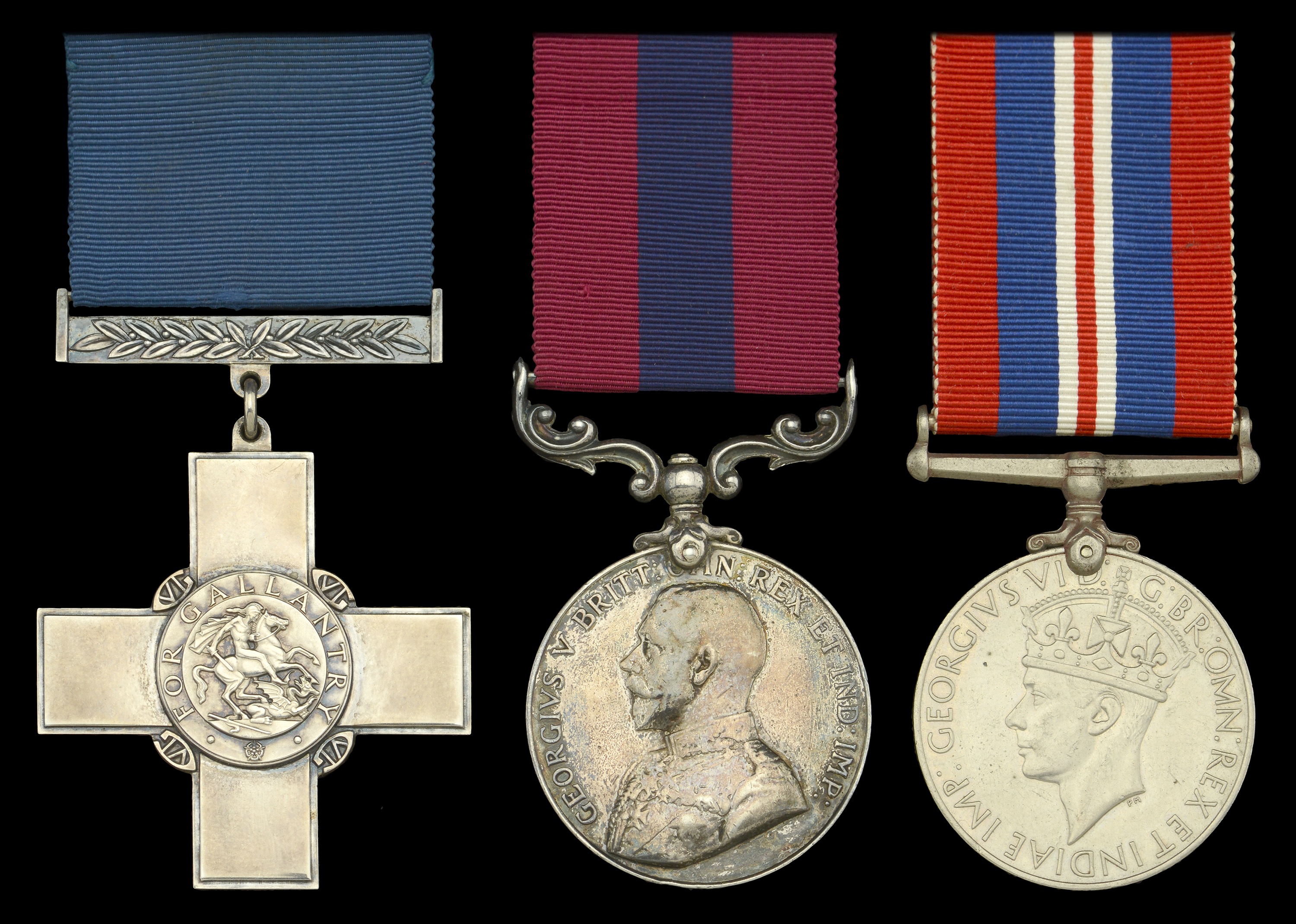An inter-War George Cross (converted E.G.M.), Great War ‘Western Front’ D.C.M. group of three awarded to Warrant Officer T. P. McTeague, Royal Air Force, late Royal Irish Rifles, who was awarded the E.G.M. for his gallantry in rescuing the future Air Chief Marshal Sir Hugh Constantine from the freezing sea after he had crashed off the Isle of Sheppey on 10 December 1928 George Cross (No. 346415 Cpl. Thomas Patrick Mc.Teague, R.A.F. 12th. April 1929.) in Royal Mint case of issue; Distinguished Conduct Medal, G.V.R. (8722 L.Cpl. T. P. Mc.Teague. 2/R. Ir: Rif:); War Medal 1939-45, in Air Ministry card box of issue, addressed to ‘T. P. McTeague, Esq., 64 Clifton Street, Belfast, N. Ireland.’, the DCM with edge bruising, polished and worn, this good fine; the GC and War Medal extremely fine (3) £12,000-£16,000 --- E.G.M. London Gazette 12 April 1929: 346415 Corporal Thomas Patrick McTeague, D.C.M., Royal Air Force (in a joint citation with Flying Officer Walter Anderson, Royal Air Force). ‘Pilot Officer H. A. Constantine while flying an aeroplane off Leysdown on 10 December 1928, crashed into the sea, about 200 yards from the shore. Corporal McTeague and Flying Officer Anderson immediately entered the sea from the shore and swam to his assistance. The weather was bitterly cold; an on-shore wind was blowing and the sea was fairly rough. Constantine, fully clothed and suffering from injuries and shock, commenced to swim ashore, but was in a state of collapse when the first swimmer (McTeague) reached him. McTeague, though exhausted himself, supported him until the arrival of Anderson, and Constantine was then brought to safety (this involved swimming for a distance of about 100 yards) by their combined efforts. The extremely prompt and timely action of Anderson and McTeague, and the gallantry and persistence they displayed, undoubtedly saved the life of Constantine.’ D.C.M. London Gazette 22 October 1917: ‘For conspicuous gallantry and devotion to duty. During an attack he displayed the greatest dash and initiative, and by rushing forward when any signs of resistance were offered he put to flight and captured at least two parties of the enemy. After reaching the objective he carried an important message back to battalion headquarters, and whilst crossing the enemy barrage he was wounded. He delivered his message safely, however, returned at once to his company, and remained on duty doing excellent and gallant work for the remainder of the operation. He refused to have his wound dressed until afterwards.’ Thomas Patrick McTeague was born in Belfast on 2 October 1893, and following the outbreak of the Great War attested for the Royal Irish Rifles, serving with the 2nd Battalion during the Great War on the Western Front from 19 September 1914 (entitled to a 1914 Star trio). Promoted Corporal, for his gallantry in 1917 he was awarded the Distinguished Conduct Medal. Demobilised following the cessation of hostilities, McTeague subsequently enlisted in the Royal Air Force in 1921, and served throughout the 1920s in the Middle East; amongst his Commanding Officers were the future Marshals of the Royal Air Force Lord Tedder and Sir Arthur Harris. As an air-gunner in twin engine bi-planes he later told how he would lean out of the aircraft in order to drop small 5lb bombs by hand onto the insurgents on the ground (One Step Further, by Marion Hebblethwaite refers). Subsequently posted to the Royal Air Force’s Armament and Gunner School on the Isle of Sheppey, McTeague was awarded the Empire Gallantry Medal for his part in rescuing Pilot Officer H. A. Constantine [later Air Chief Marshal Sir Hugh Constantine, K.B.E., C.B., D.S.O.], after he had crashed into the sea off Leysdown on 10 December 1928. He was invested with his Empire Gallantry Medal by H.R.H. The Prince of Wales (later H.M. King Edward VIII) at St. James’s Palace on 9 July 1929, and subsequently with the George Cross by H.M. King George VI at Buckingham Palace on 23 September 1941. Returning to Belfast, McTeague was promoted Sergeant and was stationed at R.A.F. Aldergrove, seeing further service during the Second World War as a Recruiting Sergeant in Belfast. His final posting was as a Warrant Officer at R.A.F. Abingdon. He died in Belfast on 28 February 1961. Sold with a group photograph featuring the recipient. Note: The recipient’s Royal Air Force Long Service and Good Conduct Medal was sold by Spink in April 2009. The location of his 1914 Star trio and 1953 Coronation Medal is unknown.










